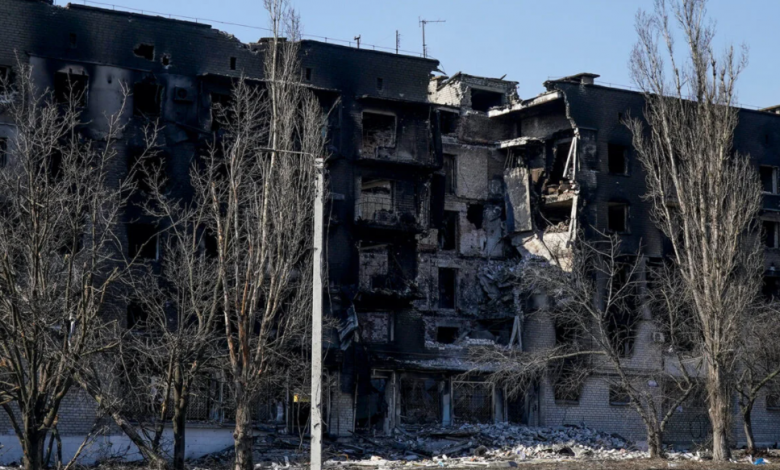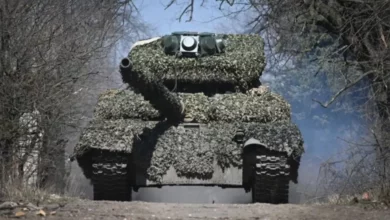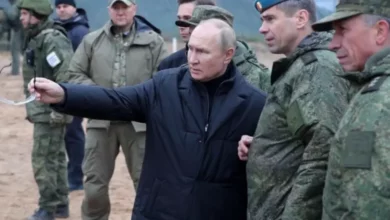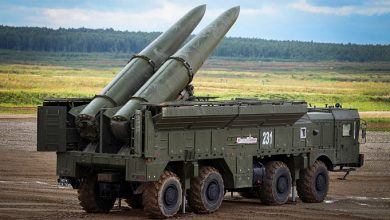How urban warfare imperils utilities, public services, and civilians

Russia’s siege of Mariupol, in Ukraine, is a grim repeat of the horrors of past attacks on cities.
This story was published in partnership with The Center for Public Integrity. This is the third in a 10-part series on nuclear risk, military technology, and the future of warfare in light of Russia’s February invasion of Ukraine.
The evening of Feb 24, outlying military sites of Mariupol, a Ukrainian city on the northern coast of the Sea of Azov, came under Russian assault. That assault has intensified in the days and weeks since, as Russian forces advancing from Crimea in the southwest and occupied Donetsk in the east encircle the city, making its capture or destruction a crucial objective of the weeks-old invasion.
The scenes out of Mariupol are haunting. Trenches hastily dug for graves house the remains of children killed in the onslaught. It is unclear how many people have died in the shelling so far, with estimates in the low thousands. Initial estimates are likely undercounts, as more corpses often emerge when there is time to clear rubble, and the true scale of the devastation is known. As of March 21, Ukrainian forces in Mariupol rejected a Russian call to surrender.
This is not the first time Mariupol has come under assault, though the scale of the present onslaught outpaces anything in recent memory. In 2015, on the morning of Jan. 24, artillery shells landed in Olimpiiska Street in northeast Mariupol. That afternoon, artillery salvos hit roughly 1,000 feet north of the first shelling, landing close to a Ukrainian Army checkpoint. At least 29 people were killed, with dozens more injured.
The January 2015 shelling was the subject of an investigation by Bellingcat, an open source investigative collaborative, which found the identities of nine Russian commanders and officers responsible for the attack. It’s a reminder that while the impact of the present war is far more devastating, parts of Ukraine have been at war since 2014. The artillery fired at Mariupol was directed by Russian officers and came from separatist-held areas of Donetsk.
The ongoing attack on Mariupol testifies to the devastation inevitable in urban warfare, and the terrible cost on civilians trapped there. As military planners watch and prepare for future wars with an understanding that cities will become battlefields—just as they were in the American wars in Iraq, in cities like Fallujah, and Afghanistan, and in cities like Aleppo, Syria, which fell under an assault supported by Russian forces. Understanding what is happening to Mariupol sheds light on just how modern urban warfare unfolds.
The 2021 census of Ukraine placed Mariupol’s population at around 470,000, roughly the same as Raleigh, North Carolina. Mariupol’s proximity to the long war in Donetsk likely prompted thousands of residents to leave before the 2022 invasion, with still more attempting to flee. As of March 16, Ukrainian officials said 30,000 people directly fled the city, with deputy mayor Serhiy Orlov saying 100,000 people left immediately following the invasion.
To help protect civilians escaping from fighting in cities, militaries will sometimes designate “safe corridors,” or routes to bring humanitarian supplies in and let civilians out. The Ukrainian government has accused Russian forces of firing on a relief convoy to the city. A March 10 Amnesty International statement declared “Russian forces’ assault on civilian populations and wanton destruction of the infrastructure of daily life violate the Geneva Conventions and international human rights law and must cease.” The Russian military allowed a convoy of civilians to leave on March 14, but did not let aid into the city.
Mariupol sits between two territories functionally claimed by Russia. Taking control of it would give Russia an overland route between its largest naval base on the Black Sea and the rest of the country, supplementing existing maritime supply lines and the bridges that extend between Crimea and Russian territory on the eastern shore of the Caucasus.
To fight a war in a city is to fight a war among civilians.
“Throughout history, military planners have viewed cities as centers of gravity,” declares the introduction to the 2018 Marine Corps manual on Military Operations on Urbanized Terrain. “Cities house the population centers, transportation hubs, seats of government, sources of wealth, centers for industry, information networks and key nodes of communication within a nation.”
One reason an invading or occupying force might facilitate the evacuation of civilians before attacking a city is to reduce the number of people who will get caught in the fighting. Because the useful terrain that provides avenues for attacking and shooting is buildings—buildings that are homes and schools and places of worship in peacetime and often continue to be used that way even in war.
Commanders and soldiers are under an obligation to protect civilians while fighting in cities. Russia has denied deliberately attacking civilians as it attempts to dislodge the Ukrainian military from defensive positions inside cities. Open source investigation outlet Bellingcat is compiling evidence of attacks on civilian areas in Ukraine, which could be used to show the deliberate targeting of civilians in war.
Artillery and airstrikes are effective ways of dislodging soldiers from a building where they are shooting anti-tank missiles at approaching vehicles. Artillery is also an effective way to collapse a building, killing people in the blast and risking the injury and death of others in the building at the time.
This can be seen in the destruction of a mall in Kyiv Monday by Russian artillery. Russia’s Ministry of Defense, in an attempt to explain the destruction of a mall in Kyiv, released drone video footage showing a Ukrainian artillery system parked next to the mall.
Everything that is harmful about urban warfare becomes worse as the battle stalls and becomes a siege.
“Urban services that are indispensable for sustaining life are disrupted by the direct, indirect and cumulative impact of hostilities,” write authors of an April 2021 report for the International Committee of the Red Cross. “Too often, inhabitants are deprived of food, water, sanitation, electricity and health care. Cuts to these basic needs are aggravated when cities are besieged, when impartial humanitarian organizations are denied access to the civilian population, or when urban conflicts become protracted.”
When a military starts to besiege a city, it may cut electrical power lines to that city to weaken the effectiveness of the defense. While there’s a protocol of the Geneva Conventions that explicitly names dams, dikes, and nuclear power plants as targets off-limits in war, that same prohibition has an exception if the power generated is used to directly support military operations.
Even when the fighting stops, the battle scars on cities from modern weapons and modern tactics remain. Raqqa, a city in northern Syria that served for four years as the center of ISIS’ claim to territorial control, was subject to an intense U.S. bombing and artillery campaign as it supported allies on the ground to retake it. The population of the city, once around 300,000, was reduced to 25,000 civilians by September 2017, primarily by those fleeing through exit routes.
When it held territory, ISIS claimed cities in both Iraq and Syria, and removing ISIS from power meant, in many cases, military assaults that drove ISIS forces from cities. As the U.S. supported forces advancing on Raqqa and Mosul, the northern Iraq city once held by ISIS, it placed buildings like bakeries, schools and hospitals on no-strike lists. In Mosul, some of those buildings were later deemed valid targets after a U.S.intelligence estimate suggested that civilians were no longer using the buildings. But in an investigation published 18 months after the end of fighting in Raqqa, Amnesty International claimed U.S.-led coalition forces were responsible for the deaths of 1,600 civilians in the city.
When the Syrian Civil War broke out in 2011, Russia backed Syria’s dictator Bashar Assad. Russian planes and artillery attacked territory held by rebel and non-government groups. The eastern part of Aleppo, Syria’s second largest city, was held by rebel forces for years, until rebel control was broken in a six-month siege by the Syrian government with the aid of the Russian military.
“As former Aleppo residents reflected on the 11th anniversary of the start of the Syrian civil war, many of them are not just reflecting on their own fates, they are watching in shock as Ukrainians face familiar horrors: bombardment, brutal siege and flight from their homes,” the Associated Press reported earlier this month.
International humanitarian law requires a military to mitigate the harm of fighting wars in cities. Battles in cities leave people without shelter, access to food, or the basic infrastructure of life, like clean water and electrical power.
And, as the world becomes more urbanized, the likelihood of urban warfare increases. That prompted the Pentagon to, in 2016, begin planning for future wars in megacities. This is true at the scale of war between nations, and it extends down to insurgencies and armed resistance movements.
How militaries fight wars, in the present and the future, will go to great lengths towards shaping what life will be like for survivors of urban battlegrounds. Everything from unexploded bombs to the repeated destruction of homes and infrastructure can cause tremendous harm, at the moment of battle and for years into the future.
Source: Popular Science





